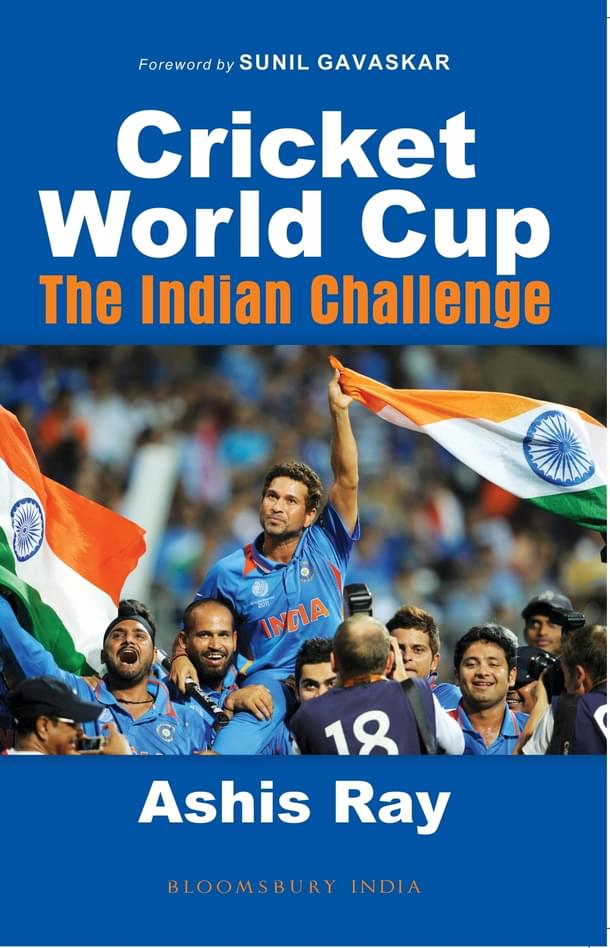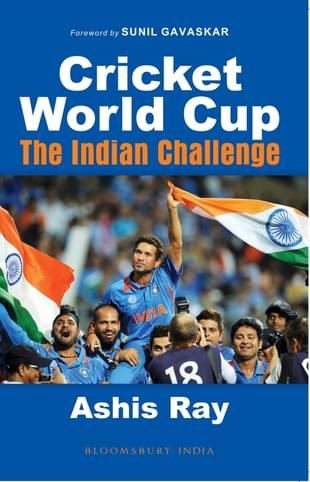Culture
Cricket World Cup: The Indian Challenge
Amarnath Govindarajan
Feb 13, 2015, 11:30 AM | Updated Feb 19, 2016, 05:41 PM IST
Save & read from anywhere!
Bookmark stories for easy access on any device or the Swarajya app.


Cricket World Cup: The Indian Challenge
Ashis Ray
Bloomsbury India
Rs 499, pp 304
Cricket World Cup: The Indian Challenge is a chronicle of the tournament from an Indian perspective, covering the previous ten tournaments and previewing the upcoming one. In the following excerpt, Ashis Ray, who was the only Asian ball-by-ball commentator of the 1983 Prudential World Cup, brings alive that fine summer’s day when history was made by Indian cricketers:
Final, 25 June: Lord’s, London
Lord’s, adjoining Regent’s Park and nestling in north-west London’s leafy St John’s Wood area, home of the Marylebone Cricket Club, founders and guardians of the game, is recognized by purists to be the Mecca of cricket. It was here, in 1932, that India made their advent on the international arena and had played a test on all visits to England since, losing every time barring 1971 and 1979 (India later won in 1986 and 2014). A total of eight defeats rendered the venue a veritable crematorium of Indian cricket. The catalogue incorporated the ignominy of being bowled out for their lowest test score ever of 42 in an incredible 77 minutes in 1974, which provoked a sneering cartoon in a British paper of a man scolding his friend: ‘I told you not to go to the toilet!’ Even in the 1975 World Cup, England pulverized the Indians to post a record score of 334 for four as India lost by a shameful margin of 202 runs.
Only Dilip Vengsarkar’s centuries in consecutive appearances in 1979 and 1982 – which was initiated to a hat trick in 1986 – had slightly lightened the load of embarrassment. In short, there was cause for trepidation in the Indian camp on the eve of the 1983 World Cup final.
But Lord’s, hosting its third consecutive World Cup final, was dressed to kill. To complement this, it transpired to be a radiantly sunny midsummer day…
…Ticket touts outside the ground—who in India are branded black marketers—have been commonplace at English grounds, including Lord’s. It was, until recently, not looked upon as an illegal activity. On this occasion, as one approached the Grace Gates (named after the illustrious W. G.), such peddlers accosted you every few yards, and only the flashing of a medallion—proof of media accreditation in that age, as opposed to laminated cards with photo identities of this security-conscious generation—deterred their doggedness. It was, obviously, good business, for tickets genuine or counterfeit were exchanging hands thick and fast and at a considerable premium.
Inside there was a festive atmosphere. West Indian supporters, with their improvised musical instruments, had arrived in strength, many, perhaps, from their south London base. Correspondingly, hirsute Sikhs, generally unfailing cheer leaders for India outside the country (noticeably at Olympic and World Cup hockey championships, where India used to dominate for decades until overshadowed by the Europeans and Australia), armed with bugles, stood out in the Indian section; many, presumably, descending from west London suburbs like Southall and Hounslow. Conch shells were in evidence in both segments.
While the galleries surrounding the immaculate turf were a kaleidoscope of sight and sound, a more subdued pavilion—a majestic, light brick mansion house, with three-tier seating and a spacious hall within known as the Long Room, where a tie and jacket are necessary to gain entry—presided over proceedings.
(Senior citizens, who used to serve as stewards at Lord’s, were notorious for their inability to recognize non-white cricketers, including prominent figures like Gavaskar, who was once stopped at the main gate, following which he initially refused an honorary membership of the MCC. As for Tiger Pataudi, when he characteristically turned up at the pavilion entrance without a tie, it was pointed out to him that he was inadequately dressed. Tiger jestfully retorted: ‘You can’t stop royalty, can you?’ and strode past the stupefied doorman, an old age pensioner, before he could recover from the remark.)
In the same spirit, Amarnath, who was vice-captain, emphasized: “There was no planning, no team discussion; no strategies were discussed…I think the motto was very simple in those days: that cricket we played very hard on the field and we used to party in the evenings.”
Those who had left home early were tucking into their egg and toast, washed down with coffee. Others wasted no time in bracing themselves with beer or, as both Afro- and Indo-Caribbeans prefer, a dash of rum.
There was not much doubt about the outcome of the match among an overwhelming majority. India, they surmised, had had their moment in the sun, and even upset the titleholders at Old Trafford. Now it was time for the West Indians to monopolize the stage. Indeed, their form since the initial reverse suggested it was crunch time for the Indians. ‘Thanks for coming,’ a West Indian friend joked as I made my way through the aforementioned pavilion door. Only the blind, irrational India backer believed otherwise.

Ominously for India, Lloyd won the toss and, unsurprisingly, decided to give his commandos a crack at the Indians in lively morning conditions. Kapil admitted: “I can’t describe in words how unhappy we were (to see the wicket). It was totally green, and Garner, Michael Holding, Marshall and Andy Roberts, those type of bowlers they had. And they’ve (the organisers) given us a green top.”
Indeed, the ball seamed; and Joel Garner, with his extra height, consistently made the ball rise chest-high from three-quarter length. But it was the faster and flatter Andy Roberts who had Gavaskar caught behind in the third over, thus imprinting in this tournament the most barren phase of this otherwise hungry Indian batsman’s career.
At the other end, though, Srikkanth, the buccaneer from Chennai, went about his task with a gay abandon. He hooked Roberts for four, pulled him for a six and then crashed him through the covers for another boundary.
“Once I got off the mark,” Srikkanth reminisced, “I decided I am going to go for the bowling…So, if they are going to bounce, I am going to hook at it…the best shot I liked was actually when I hit Michael Holding over the (bowler’s) stumps for four.”
He was in full flow when he played across the line to Marshall to be trapped lbw for 38. “It was a ridiculous choice of a shot,” Srikkanth conceded. I was on air then. Little did I realize I had just described the termination of the most substantive innings of the match.
Amarnath, as usual, steadied a capsizing ship before he was cleaned up by Holding; Patil portrayed a flurry of shots prior to becoming a victim of greed against the innocuous Gomes. India’s total appeared woefully inadequate. Yet, they didn’t lose heart. Having traversed a distance they had not dreamed of travelling before the tournament, they had nothing to lose. The ball was still seaming, and while it required another minor miracle to defend the modest score, nothing was impossible. In between my commentary spells from atop the pavilion, I would scurry to the Indian dressing room one door down to check the atmosphere therein. As the Indians took the field, Syed Abid Ali, a hero of India’s maiden test series win in England in 1971 as well as a participant in the 1975 World Cup, was down on his knees in prayer.
In between innings, Kapil told his boys: “There’s a lot of difference between there being already 183 runs on the board and they (the West Indies) having to make it.”
The West Indians started inauspiciously. Greenidge shouldered arms to a ball from Sandhu he expected to move away but which instead came back to disfigure his stumps. “I knew Gordon was not able to pick my inswinger when I used to come close to the wicket (to bowl it). When I bowled that ball, it hit the seam and started coming in, I knew it was going to hit the wicket.”
That, though, hardly unsettled Richards, who dismissively moved to 33 with seven fours to threaten to win the match by himself. Madan Lal bore the brunt of the onslaught.
Kapil and Madan’s wives left the ground, unable to withstand the butchery. Kapil went to Madan and said: “Take a break for a while.” Madan pleaded: “Give me one more over, I will get him out.”
Soon, Madan Lal impelled the Antiguan to hook; he mistimed and the superb elder that was Kapil ran back towards the midwicket boundary to take a marvellous catch over his shoulder. Richards, 25 years later still seemingly cross with himself, stated: “You get Viv Richards out, who was going so well at that particular time, you think you do stand a chance. It was a catch that was pretty inspirational to that (Indian) team.”
Haynes and Gomes, too, departed, victims of Madan, as three wickets fell in 19 balls. With Lloyd handicapped by a torn hamstring, and Bacchus not lasting long either, the West Indies plummeted to 76 for six.
But it wasn’t curtains yet. Wicketkeeper Dujon was joined by Marshall, who was no novice with the willow. Uncomfortably for India, they showed no signs of relenting as the score mounted to 119. Enter Amarnath with his deceptively slow seamers. The tinge of green made the ball hurry off the pitch. Marshall was caught, Dujon played on and Holding was plumb in front to reward Amarnath with three wickets for 12 runs in seven overs. India had worthily defeated the insurmountable West Indies by 43 runs…
…It had, obviously, been a rather low-scoring match, but this phenomenon reflected a seamer-friendly wicket. Indeed, the outcome was on a knife edge until Richards left the scene. Subsequently, the match tilted inexorably India’s way. Thousands among the capacity crowd of over 24,000—mostly Indians—invaded the field to obtain a close-up of the presentation ceremony, which took place on the middle-level balcony of the three-tier pavilion. A thunderous roar rent the air as Kapil lifted the coveted trophy. It was India’s day; their greatest moment till date in one-day cricket! The limited-overs game as far as India and Indians were concerned was never to be the same again!!
India’s breakthrough owed much to their captain’s positive frame of mind and the presence in their side of all-rounders like Kapil himself, Amarnath and Binny (the highest wicket-taker in the competition) and to the bowling of Madan Lal and Sandhu. None was express fast but of the right velocity to revel in the seaming conditions. The ball gripped even for the left-arm spin of Shastri, while, with the bat, Srikkanth, who was to become chief selector of India’s successful 2011 World Cup squad, Patil and Sharma were there to be counted when the chips were down. It was an admirably collective feat…
It was also a dizzy moment for the Indian players and the countless aficionados, and the intoxication had only begun. As the magnitude of the attainment sunk in, hundreds of Indian fans waited outside the pavilion to not just catch a glimpse of their heroes, but also to usher them back to their hotel across the road, then known as the Westmoreland, to continue the celebrations. The bar and lobby of this establishment have probably never seen such crowds before or since. The inebriation and impromptu bhangra dancing lingered late into the night…
…Prudential underwrote the event to the tune of half a million UK pounds and the gate receipts were UK £1.2 million. The aggregate attendance was 232,000.
In addition to the cup and silver medals for each player, India received £20,000, West Indies got £8000 and the losing semi-finalists, England and Pakistan, took home £4000 each.
(Excerpted with permission from Bloomsbury India)





